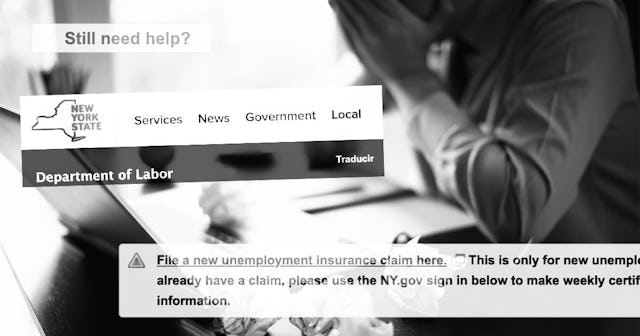I Spent Nine Hours Trying To Get Unemployment, And I’m Not the Only One

I’m one of the lucky ones. My family and I aren’t sick, we have food in the house, and I have a job that I can do remotely from home while the COVID-19 crisis is going on. I work for a small company that is doing okay so far, but given the state of the economy, they decided to shut down for two weeks. We had a big meeting (via Zoom) where they assured us that, during the two-week shutdown, we’d be able to collect unemployment.
Normally, the maximum amount you can get from unemployment insurance in New York (where I live) is $504 per week. However, the Coronavirus Aid, Relief, and Economic Security (CARES) Act, passed by Congress and signed into law by President Trump in March 2020, provides for an additional $600 per week in “enhanced” unemployment benefits.
$504 plus $600 equals around the same amount I usually make per week, so I shouldn’t end up losing anything. Worst case scenario, it just might take a little longer for me to get paid.
It typically takes 3-6 weeks to get your first unemployment check, which for me is not the end of the world. Of course, for someone who needs that money right away, to buy their groceries or to keep the lights on, it’s a different story. I’m picturing the millions of people in America who are not so fortunate—people whose businesses have closed, people who are struggling to buy food, people who may be caring for the sick or suffering from the virus themselves. They need the enhanced benefits and they need them immediately.
I went to the Department of Labor’s website, where I found the online form for filing new claims. Thank goodness, I said to myself. I knew it would be hell to try and get through on the phone this week, with 6.6 million people filing at once. The website said I could file my claim any time after 7:30am, so I went to the site at 7:30 on the dot, filled out the form, and clicked Submit. Done—right?
Well, no. Having processed my submission, the site took me to a confirmation page that said: “To complete your claim, you must call the Telephone Claims Center (TCC) and speak with a claims specialist.”
charlin janene/Reshot
So I started calling. Busy signal. Busy signal. Busy signal. Then: “Thank you for calling the New York State Department of Labor. We are currently experiencing a heavier than usual call volume… Please try calling back later.” And click, it hung up.
I would have gladly stayed on hold, even for hours, listening to the hold music in my headphones while I made breakfast, washed dishes, sat with my child and watched an educational video about kids in Thailand. But no, every time it was “Please try calling back later,” and then—click.
Over the course of the next nine hours, I would redial over 200 times, and at the end of the day I still had not completed this process. Try again tomorrow.
Of course I understand that the heavy call volume is no one’s fault. This is a crisis. We have reached the highest jobless rates since the Great Depression, people desperately need assistance, and the Department of Labor is fielding literally thousands of these calls each day.
According to Governor Cuomo’s Apr. 9th briefing, 810,000 unemployment claims have been filed in New York in the past 30 days—but public reporting suggests that twice as many tried to call in the last week of March alone. The same thing is happening across the country, with unemployment websites crashing and phone lines jammed for hours.
As I have said, I’m one of the lucky ones. I expect (I think, I hope) I’ll be back at work on April 20th. I won’t be on unemployment in the middle of summer, when the enhanced benefits are due to expire.
But most people filing for unemployment benefits are not so lucky. Many of them will still need those enhanced benefits beyond July 31st. Moreover, many people don’t have the leisure to sit there calling the Department of Labor 200 times a day, trying to get their unemployment claims processed. They are busy managing their households, homeschooling their kids while the schools are closed, and searching for a new job.
The whole point of the CARES Act is to get money to the people who need it, and to do it fast. To their credit, Congress moved quickly to pass the relief bill, hoping to get the help to the people right away. But the relief package is only as good as the federal, state, and local agencies that are disbursing the funds. If the states are not prepared to process this many unemployment claims, then the enhanced benefits are not capable of doing their job.
Just as the Congress passed the CARES Act quickly, the Department of Labor needs to act fast too, and fix this. Workers who have been laid off, furloughed, or otherwise put out of work by this disaster, are struggling to pay their bills and put food on the table. They can’t spend their days on the phone with unemployment—days wondering when or if they’ll get their checks.
State organizations, particularly the unemployment office in every state, need to act in concert with the federal government to help every unemployed worker stay afloat. If they don’t, the economy—along with the very real people and families who make up the economy—is only headed for deeper trouble.
This article was originally published on